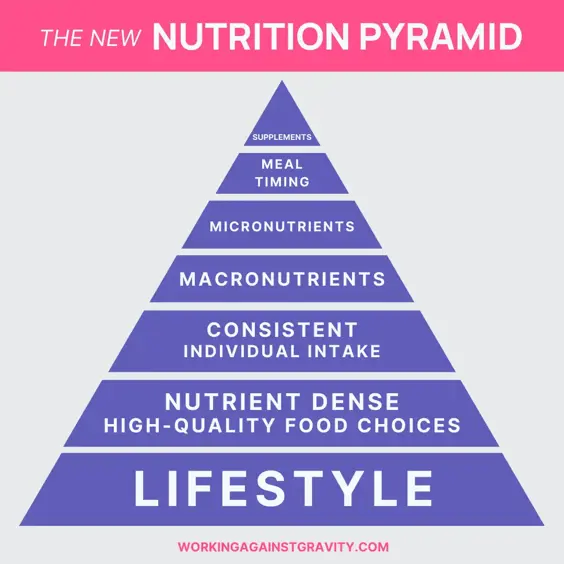
Who doesn’t love a good nutrition pyramid remix?!
This article dives into a spin on the traditional nutrition pyramid and explains, in detail, the building block steps and principles we rely on to help our clients find a nutrition approach that works for them.
In addition to describing each of the levels of the nutrition pyramid, we’ll emphasize the importance of starting at the bottom; and why building a solid base and foundation is essential for your long-term success, growth, and sustainability.

Let’s get right to it!
Advertisement
Lifestyle
The base and BIGGEST part of the Nutrition Pyramid is Lifestyle. In this remix, think of Lifestyle as the chorus or the catchy beat; it has to be great for the song to really work!
Without a solid base and foundation, anything you try to build and do above it will be on “shaky ground”. Little by little, as you progress through your journey, things are more likely to crumble and fall apart.
Focus on the foundation and create a bottom-up mindset to build your nutrition approach. This will help you get the MOST bang for your buck and your health journey will naturally build on itself. It will maximize the impact all the layers above will have as you progress.
What does a “healthy Lifestyle” mean?
Lifestyle factors include things like stress management, sleep quantity and quality, exercise, etc. If the word “habits” jumps to mind, then you’re right! These lifestyle factors will give you the biggest return on your investment.
Simply put, the behaviors and habits that you reinforce day in and day out make up your Lifestyle. They are the things you “just do”; with little thought and relative ease.
Advertisement
It’s important to highlight the fact that the Lifestyle portion of the WAG nutrition pyramid is not about turning your life upside down and changing your lifestyle to fit a specific nutrition program.
Consider what types of boundaries or principles you can commit to and follow in YOUR day-to-day. This is going to vary for every single individual, but it is so important to understand. If a nutrition program asks you to never go out to eat, but you travel often for work - do you think this would fit your lifestyle long-term? Probably not! This is why finding the right fit when it comes to a nutrition program will be the most beneficial for you.
Need help figuring this out for yourself? Seek the advice of a WAG 1:1 nutrition coach who can support you and help find you a tailored approach that will work specifically for you and your lifestyle!
Nutrient-Dense High-Quality Foods
The next level of the Nutrition Pyramid is Nutrient Dense High-Quality Foods or the quality of your food choices.
You guessed it! The quality of your food matters; it matters a lot.
Advertisement
Why does food quality matter?
What food choices are readily available in your house or office? Is your fridge and freezer stocked with mostly high-quality, nutrient-dense foods or every flavor of Ben & Jerry’s? Set yourself up for success by having a variety of high-quality food choices already prepped and ready when it is time to eat!
This is why working on the base of the pyramid first, Lifestyle, is so crucial. Making the nutrient-dense whole food choice is that much easier with the right mix of habits and behaviors in place beforehand.
At WAG, we suggest 85-90% of your intake comes from nutrient-dense high-quality foods. This ensures the majority of the food you consume is minimally processed. It’s a win-win!
That said, a diet that doesn’t bend will eventually break. That’s where the remaining 10-15% of your intake comes in. Incorporating and practicing flexibility can help make things easier, more fun, and your progress more likely to stick - which is the goal after all!
Through a deliberate effort to include whole foods and minimally processed foods in your diet, you will feel more full and also enjoy a reduction in sugar and processed food cravings. Another win-win!
Advertisement
Increasing your consumption of nutrient-dense high-quality foods will have a HUGE impact on your overall health & wellness in so many ways. Which is why, after Lifestyle, this block deserves the second level in the nutrition pyramid.
Consistent Individual Intake
The third level of the Nutrition Pyramid is Consistent Individual Intake which comes down to eating a consistent amount of food day in and day out; a consistent amount of calories.
Before we go any further into this section of the pyramid, it is important to highlight the fact that up to this point, the word “calorie” has been on vacation and not mentioned in this article. This isn’t an accident. Only after you’ve dialed in habits, behaviors (Lifestyle) and food choices do calories begin to truly make a difference in a sustainable nutrition program.
Just about anyone can count calories for a short period of time and see relatively quick progress. But those changes are less likely to last without the right habits and behaviors in place to support and sustain that progress.
You are more likely to find yourself reverting back to “old ways or habits” when you skip the first two levels of the pyramid. Once again, the importance of starting and spending time on the bottom sections of the pyramid cannot be understated if you want to not only make progress, but sustain it!
Advertisement
How many calories should I eat?
Great question.
Your individual intake requirement is very unique to you and your specific goals. If your goal is fat loss, you typically need to be in a caloric deficit (eating fewer calories than you are burning day to day). If your goal is to gain muscle, you usually need to eat in a caloric surplus. Similarly, things like your movement through the day (do you work at a desk or are you running around a hospital?), exercise style and intensity, your height, your weight, etc. all play a role in your caloric needs.
Regardless of the specific amount of calories you eat, the key takeaway is consistency. Your body craves routine and responds best to a steady stream of calories day in and day out.
Consistency also provides reliable data and real-time feedback. This data and feedback is necessary for you and your coach to consider when determining the most effective adjustments to your caloric needs. WAG coaches are specifically trained to use the feedback they get from their clients in weekly check-ins to help personalize a nutrition and lifestyle plan unique to that client.
Whether you have counted calories before or are counting calories now, remember… calories count! And achieving consistency in your intake is the key!
Advertisement
Macronutrients
The next level of the Nutrition Pyramid is Macronutrients, or “macros”. Hello, protein, carbs, and fats!”
This layer of the nutrition pyramid requires you to look beyond calories and start monitoring what those calories are made of.
Each macro has different functions within your body so paying close attention to your macro ratios is the next natural step to help you reach your health and performance goals. Much like specific caloric needs, the best mix of macros for you depends on a variety of factors such as your activity level, the type of exercise you do, and your goals.
Macronutrients’ role in the nutrition pyramid?
Protein, carbs and fats are the three macronutrients and because they are the next step to “counting calories” they’re higher on the pyramid.
Let’s take a look at some of the basic functions of each:
Advertisement
- First up is Protein. It helps with building and/or maintaining muscle mass. Protein also helps keep you full, recover from workouts, and is a staple in a weight loss journey! One gram of protein contains four calories.
- Next up is Carbohydrates! Carbs are wonderful because they are your bodies' preferred and most easily accessible source of fuel. They also help support recovery from workouts. Eating carbs in the right proportions for you will keep your body running smoothly. Just like protein, one gram of carbs contains four calories.
- Last up is Fat. Fat plays an important role in your ability to survive and feel good! Fat is also the highest calorie food… holding 9 calories per gram. Fat slows the digestion of food down, helping your stay fuller longer - #winning! It also helps with the absorption of vitamins and minerals in the body.
For a deeper dive into counting and tracking macros check out the WAG Nutrition Guide.
Micronutrients
The fifth level of the Nutrition Pyramid is Micronutrients.
Micronutrients are all the vitamins and minerals our body needs to perform and operate at its best. Your body needs much smaller amounts of these micronutrients compared to macronutrients; hence the name “micro”. Some examples of the many micronutrients that play an important role in your health include Vitamin B, Vitamin C, Vitamin D, Calcium, and Iron.
Where can I get micronutrients?
You get a lot of our micronutrients from eating a diet rich in whole foods (yep, another reason why the building block approach is SO important). By increasing your intake of high-quality foods you will, by default, get more micronutrients in your diet.
There is a time and place to do a deep dive into micronutrients. If whole foods make up at least 85% of your diet, that is a fantastic start. You can grow from there and focus on any deficiencies you may have (with a doctor!) or different micronutrients to help you feel your absolute best.
Advertisement
Meal Timing
The next level of the Nutrition Pyramid is Meal Timing.
The timing of your meals can be beneficial if you are focusing on maximizing performance in the gym or competition floor and capitalizing on every possible avenue for improvement to gain that extra edge.
Meal Timing is quite the buzzword these days and a quick Google search often creates more confusion than clarity.
Meal timing and the nutrition pyramid
Meal timing can also look a variety of ways, from spreading out high volume carbs throughout the day to keep you from feeling too hungry, to avoiding a higher fat meal before your workout because fat can slow down digestion.
In the end, much like calories, macros, and micronutrients, the “right” meal timing strategy will vary from person to person and be largely driven by a variety of lifestyle factors. This is why it sits higher on the nutrition pyramid.
Advertisement
There are some general guidelines that can be helpful and guide you in determining the best mealtime strategy for you. This guide has a ton of Meal Timing tips & tricks if you want to dive in!
Supplements
Sitting at the tippy-top of the Nutrition Pyramid is Supplements.
These tend to be the “magical” solutions you hear people talk about. The latest pre-workout and BCAA mix, hydration tablet, or quick-digesting, protein-packed, plant-based protein powder.
The thing about supplements is that they are just that: they are meant to supplement an already controlled, high-quality, nutrient-dense diet supported by a sound lifestyle.
When should I use supplements?
There is a time and a place for supplements! But they should be the sprinkle toppings on your nutrition approach sundae. The truth is, spending time, energy, and money on supplements will not get you the results you want if you’re ignoring the lower sections of the pyramid.
Advertisement
Be mindful not to get caught up in the “supplement trap” and find yourself relying on the smallest portion of the pyramid to give you the big, long-lasting changes you want to see!
That is a nutrition pyramid remix “rap”!
Before getting too fancy with macros, micros, meal timing, or the new “best” supplement in the market, ask yourself:
“Have I developed the necessary habits and behaviors, maximized the quality of my food choices, and achieved the prerequisite consistency at the calorie intake level to really maximize the time and energy spent at the higher sections of the pyramid?”
Spend the time working on the basics and building a strong foundation. You are worth the time, energy and effort.
Advertisement
Interested in learning more about the Nutrition Pyramid? Check out this Podcast! Adee and Michael take a deep dive and explain each section and the building block approach to nutrition that WAG knows, loves and uses.
Schedule a Free Intro Call
Working Against Gravity has led the macro tracking and health space for over a decade. Our team doesn’t just understand the science of nutrition—we’ve spent years mastering the art of tailoring it to fit your life. That means no cookie-cutter plans, just real strategies that have worked for over 30,000 people.
Schedule a free call with our team to learn how working with a 1-on-1 WAG coach will help you reach your goals.



